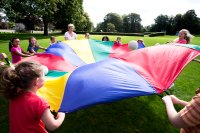Building School Community Through Physical Activity
Physical activity provides an opportunity to build character, use teamwork, and foster a sense of belonging in schools.
Physical education is important not only for an individual student’s health and well-being, but also for the development of a strong and healthy school community. Whether it be structured play in physical education class, extracurricular clubs, or recess, physical activity contributes to building a better school culture.
Foster Relationships
Teaching physical education offers a unique opportunity to work with each of my school’s 750 students each week. I make it a priority to learn and remember every student’s name. A name is something our students carry with them everywhere and is a part of their identity that doesn’t change. Addressing each student by name demonstrates that I care about them as individuals. It is a simple first step toward establishing trust with a student.
Physical education also offers an opportunity to help students develop relational skills such as sharing and using kind words during play. For example, students can work in pairs to create objectives that involve both verbal and nonverbal communication. I use one game called Shipwreck where three to five students hold the outside of a Hula-Hoop and move across the play area until I say “Shipwreck!” They must then drop their ship (Hula-Hoop) and stand inside of it. The last group inside the ship must go back to the start line.
Students learn how to work collaboratively in physical education classes. Another activity, called Sky Ball, is a modified volleyball game where students catch and throw rather than bumping, setting, and spiking. I assign a team captain, and we discuss their role. The captain has the final say on how the teams will function, using input from other students.
Students also develop skills in conflict resolution through physical education. A common example is when two students on different teams have a disagreement over a rule of the game. When I let them solve it, rather than interjecting my thoughts and providing a solution, students are able to work toward a resolution. Whether it is solved in a healthy or unhealthy manner, students benefit from a discussion about the solution, how it worked, and other alternatives that might be possible if they are faced with a similar conflict in the future.
The social and emotional skills developed through physical education help students create meaningful relationships with their teacher and with each other. Strong relationships built on trust and understanding contribute to a positive school culture.
Sharing Experiences Through Physical Activity
Sharing successes from physical education classes can build positive culture throughout the school.
During our Jump Rope unit, we set up three poster boards in our main hallway that list students who participate in the one-minute, two-minute, or three-minute jump rope club during the month. When students reach one of the marks, they sign the poster board for the entire school to see their success. When they finally reach their goal and I hand them the Sharpie to sign their name, their joy is apparent. Students now anticipate the jump rope activity and ask when it will begin again.
Physical activity doesn’t have to take place exclusively in physical education classes. Extracurricular activities can also contribute to a healthy, positive school culture. At our school, students, teachers, and any other staff members train two days a week after school for 10 weeks through a program we established called Fit Kidz. In this program, I share one character trait each week that can be developed during the training. When we discuss perseverance, we talk about how we strive for a goal. There will be days when we have a strong desire to reach our goal and other days when we aren’t as eager to reach our goal, but we continue to push ourselves to be our best. Other values to discuss include the elements of hard work, goal setting, and being our personal best.
At the conclusion of the program, participants run a 5K in our community. The final event gives students a chance to celebrate their accomplishments. It also allows the school community to come together to support one another.
Another option for building community through physical activity is a morning walk club. Students, teachers, and administrators can meet a few days a week in the mornings and walk around the school grounds. The walks not only provide a way to work on physical well-being but also allow different constituencies to interact in an informal way.
Engage teachers and administrators in physical activities at the school. One teacher in my school started an after-school dance program for students. Teachers also participate in the annual Play Day Tug-of-War. Adults in the school who take part in physical activity serve as role models for healthy living and an active lifestyle.
Physical activity provides an opportunity to build character, use teamwork, and foster a sense of belonging in schools. It is important, not only to individual students, but to the overall health of the school community.
